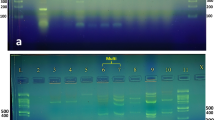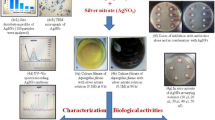Abstract
Carbapenem-resistant Acinetobacter baumannii (CRAB) remains as a serious cause of infectious diseases and septic mortality in hospitalized patients worldwide. This study was conducted to evaluate the antimicrobial effect of imipenem conjugated silver nanoparticles (AgNPs) on resistant isolated A. baumannii from nosocomial infections.
The antimicrobial susceptibility test of 100 A. baumannii clinical isolates against different antibiotics was performed. PCR was used to confirm bacterial resistance and to identify different genes encoding Ambler class β-lactamases. The chemically synthesized AgNPs were characterized using UV-vis spectroscopy, X-ray diffraction (XRD), transmission electron microscopy (TEM), and Fourier-transform infrared (FTIR). The stability, drug release kinetic, and cytotoxicity (MTT assay) of AgNPs were also investigated. The imipenem were conjugated with AgNPs, and conjugants were characterized as discussed above. Minimum inhibitory concentration (MIC) of the AgNPs and conjugants were tested against A. baumannii isolates and compared with imipenem alone.
The results revealed that among all isolated A. baumannii, 76% showed resistant to imipenem (MIC ≥ 64 μg/mL to ≥ 256 μg/mL). The blaOXA-23, blaPER, blaOXA-40, and blaIMP genes were the most prevalent genes. UV-vis spectroscopy, XRD, TEM, and FTIR analysis confirmed synthesis of AgNPs (average size of 10–40 nm) and conjugation with imipenem. The release of imipenem from AgNPs can be defined as Fickian diffusion model. The MIC values of AgNPs conjugated with imipenem against resistant A. baumannii were decreased in a dose dependent manner and were based on existence of resistant genes. The AgNPs also showed low cytotoxic effects.
The results suggest that imipenem-AgNPs has a strong potency as a powerful antibacterial agent against multi-resistant A. baumannii.







Similar content being viewed by others
References
Peleg AY, Seifert H, Paterson DL (2008) Acinetobacter baumannii: emergence of a successful pathogen. Clin Microbiol Rev 21:538–582. https://doi.org/10.1128/CMR.00058-07
Perez F, Hujer AM, Hujer KM, Decker BK, Rather PN, Bonomo RA (2007) Global challenge of multidrug-resistant Acinetobacter baumannii. Antimicrob Agents Chemother 51:3471–3484. https://doi.org/10.1128/AAC.01464-06
Eliopoulos GM, Maragakis LL, Perl TM (2008) Acinetobacter baumannii: epidemiology, antimicrobial resistance, and treatment options. Clin Infect Dis 46:1254–1263. https://doi.org/10.1086/529198
Park YK, Peck KR, Cheong HS, Chung D-R, Song J-H, Ko KS (2009) Extreme drug resistance in Acinetobacter baumannii infections in intensive care units, South Korea. Emerg Infect Dis 15(8):1325–1327. https://doi.org/10.3201/eid1508.080772
Al-Agamy MH, Khalaf NG, Tawfick MM, Shibl AM, El Kholy A (2014) Molecular characterization of carbapenem-insensitive Acinetobacter baumannii in Egypt. Int J Infect Dis 22:49–54. https://doi.org/10.1016/j.ijid
Hammoudi D, Moubareck CA, Hakime N, Houmani M, Barakat A, Najjar Z, Suleiman M, Fayad N, Sarraf R, Sarkis DK (2015) Spread of imipenem-resistant Acinetobacter baumannii co-expressing OXA-23 and GES-11 carbapenemases in Lebanon. Int J Infect Dis 36:56–61. https://doi.org/10.1016/j.ijid
Rodloff AC, Goldstein EJC, Torres A (2006) Two decades of imipenem therapy. J Antimicrob Chemother 58:916–929. https://doi.org/10.1093/jac/dkl354
Mihu MR, Sandkovsky U, Han G, Friedman JM, Nosanchuk JD, Martinez LR (2010) The use of nitric oxide releasing nanoparticles as a treatment against Acinetobacter baumannii in wound infections. Virulence 1:62–67. https://doi.org/10.4161/viru.1.2.10038
Mihu MR, Martinez LR (2011) Novel therapies for treatment of multi-drug resistant Acinetobacter baumannii skin infections. Virulence 2:97–102
Baptista PV, McCusker MP, Carvalho A, Ferreira DA, Mohan NM, Martins M, Fernandes AR (2018) Nano-strategies to fight multidrug resistant bacteria “A Battle of the Titans” Frontiers in. Microbiology 9:1441. https://doi.org/10.3389/fmicb.2018.01441
Franci G, Falanga A, Galdiero S, Palomba L, Rai M, Morelli G, Galdiero M (2015) Silver nanoparticles as potential antibacterial agents. Molecules 20:8856–8874. https://doi.org/10.3390/molecules20058856
Ip M, Lui SL, Poon VK, Lung I, Burd A (2006) Antimicrobial activities of silver dressings: an in vitro comparison. J Med Microbiol 55:59–63. https://doi.org/10.1099/jmm.0.46124-0
Bhainsa KC, D’souza S (2006) Extracellular biosynthesis of silver nanoparticles using the fungus Aspergillus fumigatus. Colloid surfaces B 47:160–164. https://doi.org/10.1016/j.colsurfb.2005.11.026
Sondi I, Salopek-Sondi B (2004) Silver nanoparticles as antimicrobial agent: a case study on E. coli as a model for gram-negative bacteria. J Colloid Interface Sci 275:177–182. https://doi.org/10.1016/j.jcis.2004.02.012
Kim JS, Kuk E, Yu KN, Kim J-H, Park SJ, Lee HJ, Kim SH, Park YK, Park YH, Hwang C-Y (2007) Antimicrobial effects of silver nanoparticles. Nanomedicine: NBM 3:95–101. https://doi.org/10.1016/j.nano.2006.12.001
Gurunathan S (2014) Rapid biological synthesis of silver nanoparticles and their enhanced antibacterial effects against Escherichia fergusonii and Streptococcus mutans. Arab J Chem. https://doi.org/10.1016/j.arabjc
Henglein A, Giersig M (1999) Formation of colloidal silver nanoparticles: capping action of citrate. J Phys Chem B 103:9533–9539. https://doi.org/10.1021/jp9925334
Murugadoss A, Chattopadhyay A (2007) A ‘green’chitosan–silver nanoparticle composite as a heterogeneous as well as micro-heterogeneous catalyst. Nanotechnol 19:015603. https://doi.org/10.1088/0957-4484/19/01/015603
Kuo CH, Chiang TF, Chen LJ, Huang MH (2004) Synthesis of highly faceted pentagonal-and hexagonal-shaped gold nanoparticles with controlled sizes by sodium dodecyl sulfate. Langmuir 20:7820–7824. https://doi.org/10.1021/la049172q
Naqvi SZ, Kiran U, Ali MI, Jamal A, Hameed A, Ahmed S, Ali N (2013) Combined efficacy of biologically synthesized silver nanoparticles and different antibiotics against multidrug-resistant bacteria. Int J Nanomedicine 8:3187–3195. https://doi.org/10.2147/IJN.S49284
Masri A, Anwar A, Ahmed D, Siddiqui RB, Shah MR, Ahmed Khan N (2018) Silver nanoparticle conjugation-enhance antibacterial efficacy of clinically approved drugs cephradine and vildagliptin. Antibiotics 7:100. https://doi.org/10.3390/antibiotics7040100
Naimi-Shamel N, Pourali P, Dolatabadi S (2019) Green synthesis of gold nanoparticles using Fusarium oxysporum and antibacterial activity of its tetracycline conjugant. J Mycol Med 29:7–13. https://doi.org/10.1016/j.mycmed.2019.01.005
Clinical and Laboratory Standards Institute. Performance standards for antimicrobial susceptibility testing. CLSI M100-S22. Available: http://clsi.org/blog/2012/01/13/clsi-publishes-2012-antimicrobial-susceptibility-testing-standards/. Accessed 23 January 2015.
Woodford N, Ellington MJ, Coelho JM, Turton JF, Ward ME, Brown S, Amyes SG, Livermore DM (2006) Multiplex PCR for genes encoding prevalent OXA carbapenemases in Acineto-bacter spp. Int J Antimicrob Agents 27:351–353
Sarhaddi N, Soleimanpour S, Farsiani F, Mosavat A, Dolatabadi S, Salimizand H, Amel Jamehdar S (2016) Elevated prevalence of multidrug-resistant Acinetobacter baumannii with extensive genetic diversity in the largest burn center of northeast Iran. J Glob Antimicrob Res 8:60–66. https://doi.org/10.1016/j.jgar.2016.10.009
Bahador A, Raoofian R, Farshadzadeh Z, Beitollahi L, Khaledi A, Rahimi S, Mokhtaran M, Mehrabi-Tavana A, Esmaeili D (2015) The prevalence of ISAba1 and ISAba4 in Acinetobacter baumannii species of different international clone lineages among patients with burning in Tehran, Iran. Jundishapur J Microbiol 8(7):e17167. https://doi.org/10.5812/jjm.17167v2
Wan G, Ruan L, Yin Y, Yang T, Ge M, Cheng X (2016) Effects of silver nanoparticles in combination with antibiotics on the resistant bacteria Acinetobacter baumannii. Int J Nanomedicine 11:3789–3800
Payne JN, Waghwani HK, Connor MG, Hamilton W, Tockstein S, Moolani H, Chavda F, Badwaik V, Lawrenz MB, Dakshinamurthy R (2016) Novel synthesis of kanamycin conjugated gold nanoparticles with potent antibacterial activity. Front Microbiol 7:607. https://doi.org/10.3389/fmicb.2016.00607
Rastogi L, Kora AJ, Arunachalam J (2012) Highly stable, protein capped gold nanoparticles as effective drug delivery vehicles for amino-glycosidic antibiotics. Mater Sci Eng 32:1571–1577. https://doi.org/10.1016/j.msec.2012.04.044
Bhattacharya D, Saha B, Mukherjee A, Santra CR, Karmakar P (2012) Gold nanoparticles conjugated antibiotics: stability and functional evaluation. Nanosci Nanotechnol 2(2):14–21. https://doi.org/10.5923/j.nn.20120202.04
Kazemi D, Salouti M, Rostamizadeh K, Zabihian A (2014) Development of gentamicin-loaded solid lipid nanoparticles: evaluation of drug release kinetic and antibacterial activity against Staphylococcus aureus. Int J Pharmaceut Res Innov 7:1–6
Sadri M, Mohammadi A, Hosseini H (2016) Drug release rate and kinetic investigation of composite polymeric nanofibers. Nanomed Res J 1(2):112–121. https://doi.org/10.7508/nmrj.2016.02.008
Saha B, Bhattacharya J, Mukherjee A, Ghosh AK, Santra CR, Dasgupta AK, Karmakar P (2007) In vitro structural and functional evaluation of gold nanoparticles conjugated antibiotics, Nanoscale Res Lett 2: 614–622.DOI. https://doi.org/10.1007/s11671-007-9104-2
Pourali P, Badiee SH, Manafi S, Noorani T, Rezaei A, Yahyaei B (2017) Biosynthesis of gold nanoparticles by two bacterial and fungal strains, Bacillus cereus and Fusarium oxysporum, and assessment and comparison of their nanotoxicity in vitro by direct and indirect assays. Electron J Biotechnol 29:86–93
Gwinn MR, Vallyathan V (2006) Nanoparticles: health effects—pros and cons. Environ Health Perspect 114:12
Anselmo AC, Mitragotri S (2016) Nanoparticles in the clinic. Bioeng Transl Med 1:10–29. https://doi.org/10.1002/btm2.10003
Beyth N, Houri-Haddad Y, Domb A, Khan W, and Hazan A (2015) Alternative antimicrobial approach: nano-antimicrobial materials Evid-Based Compl Alt ID 246012, 16 pages. https://doi.org/10.1155/2015/246012.
Birla SS, Tiwari V, Gade A, Ingle A, Yadav A, Rai M (2009) Fabrication of silver nanoparticles by Phoma glomerata and its combined effect against Escherichia coli, Pseudomonas aeruginosa and Staphylococcus aureus. Lett Appl Microbiol 48:173–179. https://doi.org/10.1111/j.1472-765X.2008.02510.x
Chen J, Li S, Luo J, Wang R, Ding W (2016) Enhancement of the antibacterial activity of silver nanoparticles against phytopathogenic bacterium Ralstonia solanacearum by stabilization. J Nanomater ID 7135852:15 pages. https://doi.org/10.1155/2016/7135852
Zhang T, Wang L, Chen Q, Chen C (2014) Cytotoxic potential of silver nanoparticles. Yonsei Med J 55(2):283–291. https://doi.org/10.3349/ymj.2014.55.2.283
Niakan S, Niakan M, Hesaraki S, Nejadmoghaddam MR, Moradi M, Hanafiabdar M, Allamezadeh R, Sabouri M (2013) Comparison of the antibacterial effects of nanosilver with 18 antibiotics on multidrug resistance clinical isolates of Acinetobacter baumannii. Jundishapur J Microbiol 6(5):e8341. https://doi.org/10.5812/jjm.8341
Acknowledgments
This study was approved by Islamic Azad University, Neyshabur Branch, as a MS thesis.
Author information
Authors and Affiliations
Corresponding author
Ethics declarations
Conflict of Interest
The authors declare that they have no conflict of interest.
Ethical Approval
Not required.
Additional information
Publisher’s Note
Springer Nature remains neutral with regard to jurisdictional claims in published maps and institutional affiliations.
Rights and permissions
About this article
Cite this article
Zendegani, E., Dolatabadi, S. The Efficacy of Imipenem Conjugated with Synthesized Silver Nanoparticles Against Acinetobacter baumannii Clinical Isolates, Iran. Biol Trace Elem Res 197, 330–340 (2020). https://doi.org/10.1007/s12011-019-01962-6
Received:
Accepted:
Published:
Issue Date:
DOI: https://doi.org/10.1007/s12011-019-01962-6




